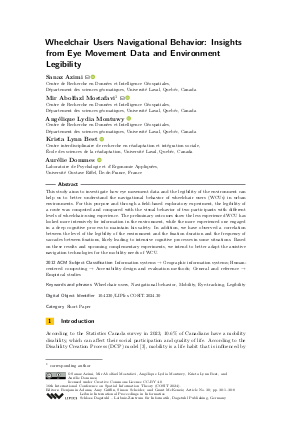Wheelchair Users Navigational Behavior: Insights from Eye Movement Data and Environment Legibility (Short Paper)
Authors
Sanaz Azimi  ,
Mir Abolfazl Mostafavi
,
Mir Abolfazl Mostafavi  ,
Angélique Lydia Montuwy
,
Angélique Lydia Montuwy  ,
Krista Lynn Best
,
Krista Lynn Best  ,
Aurélie Dommes
,
Aurélie Dommes 
-
Part of:
Volume:
16th International Conference on Spatial Information Theory (COSIT 2024)
Part of: Series: Leibniz International Proceedings in Informatics (LIPIcs)
Part of: Conference: Conference on Spatial Information Theory (COSIT) - License:
 Creative Commons Attribution 4.0 International license
Creative Commons Attribution 4.0 International license
- Publication Date: 2024-09-09
File

PDF
LIPIcs.COSIT.2024.30.pdf
- Filesize: 1.21 MB
- 8 pages
Document Identifiers
Subject Classification
ACM Subject Classification
- Information systems → Geographic information systems
- Human-centered computing → Accessibility design and evaluation methods
- General and reference → Empirical studies
Keywords
- Wheelchair users
- Navigational behavior
- Mobility
- Eye-tracking
- Legibility
Metrics
- Access Statistics
-
Total Accesses (updated on a weekly basis)
0PDF Downloads0Metadata Views
Abstract
This study aims to investigate how eye movement data and the legibility of the environment can help us to better understand the navigational behavior of wheelchair users (WCUs) in urban environments. For this purpose and through a field-based exploratory experiment, the legibility of a route was computed and compared with the visual behavior of two participants with different levels of wheelchair-using experience. The preliminary outcomes show the less experienced WCU has looked more intensively for information in the environment, while the more experienced one engaged in a deep cognitive process to maintain his safety. In addition, we have observed a correlation between the level of the legibility of the environment and the fixation duration and the frequency of saccades between fixations, likely leading to intensive cognitive processes in some situations. Based on these results and upcoming complementary experiments, we intend to better adapt the assistive navigation technologies for the mobility needs of WCU.
Cite As Get BibTex
Sanaz Azimi, Mir Abolfazl Mostafavi, Angélique Lydia Montuwy, Krista Lynn Best, and Aurélie Dommes. Wheelchair Users Navigational Behavior: Insights from Eye Movement Data and Environment Legibility (Short Paper). In 16th International Conference on Spatial Information Theory (COSIT 2024). Leibniz International Proceedings in Informatics (LIPIcs), Volume 315, pp. 30:1-30:8, Schloss Dagstuhl – Leibniz-Zentrum für Informatik (2024)
https://doi.org/10.4230/LIPIcs.COSIT.2024.30
BibTex
@InProceedings{azimi_et_al:LIPIcs.COSIT.2024.30,
author = {Azimi, Sanaz and Mostafavi, Mir Abolfazl and Montuwy, Ang\'{e}lique Lydia and Best, Krista Lynn and Dommes, Aur\'{e}lie},
title = {{Wheelchair Users Navigational Behavior: Insights from Eye Movement Data and Environment Legibility}},
booktitle = {16th International Conference on Spatial Information Theory (COSIT 2024)},
pages = {30:1--30:8},
series = {Leibniz International Proceedings in Informatics (LIPIcs)},
ISBN = {978-3-95977-330-0},
ISSN = {1868-8969},
year = {2024},
volume = {315},
editor = {Adams, Benjamin and Griffin, Amy L. and Scheider, Simon and McKenzie, Grant},
publisher = {Schloss Dagstuhl -- Leibniz-Zentrum f{\"u}r Informatik},
address = {Dagstuhl, Germany},
URL = {https://drops.dagstuhl.de/entities/document/10.4230/LIPIcs.COSIT.2024.30},
URN = {urn:nbn:de:0030-drops-208459},
doi = {10.4230/LIPIcs.COSIT.2024.30},
annote = {Keywords: Wheelchair users, Navigational behavior, Mobility, Eye-tracking, Legibility}
}
Author Details
- Centre de Recherche en Données et Intelligence Géospatiales, Département des sciences géomatiques, Université Laval, Quebéc, Canada
- Centre de Recherche en Données et Intelligence Géospatiales, Département des sciences géomatiques, Université Laval, Quebéc, Canada
- Centre de Recherche en Données et Intelligence Géospatiales, Département des sciences géomatiques, Université Laval, Quebéc, Canada
- Centre interdisciplinaire de recherche en réadaptation et intégration sociale, École des sciences de la réadaptation, Université Laval, Quebéc, Canada
References
- Ali Afghantoloee, Mir Abolfazl Mostafavi, Geoffrey Edwards, and Amin Gharebaghi. Personalized Legibility of an Indoor Environment for People with Motor Disabilities: A New Framework. ISPRS International Journal of Geo-Information, 9(11):649, October 2020. URL: https://doi.org/10.3390/IJGI9110649.
- Fang Chen, Jianlong Zhou, Yang Wang, Kun Yu, Syed Z. Arshad, Ahmad Khawaji, and Dan Conway. Robust Multimodal Cognitive Load Measurement. Cham: Springer, 2016. URL: https://doi.org/10.1007/978-3-319-31700-7.
-
Patrick Fougeyrollas, René Cloutier, Hélène Bergeron, Jacques Côté, and Ginette St-Michel. The Quebec classification: Disability creation process. INDCP, 1999.

- Amin Gharebaghi, Mir Abolfazl Mostafavi, Geoffrey Edwards, Patrick Fougeyrollas, Patrick Morales-Coayla, François Routhier, Jean Leblond, and Luc Noreau. A confidence-based approach for the assessment of accessibility of pedestrian network for manual wheelchair users. In Lecture Notes in Geoinformation and Cartography, pages 463-477. Springer Berlin Heidelberg, 2017. URL: https://doi.org/10.1007/978-3-319-57336-6_32.
- Ioannis Giannopoulos, Peter Kiefer, and Martin Raubal. GeoGazemarks: Providing gaze history for the orientation on small display maps. In Proceedings of the 14th ACM International Conference on Multimodal Interaction, pages 165-172, 2012. URL: https://doi.org/10.1145/2388676.2388711.
-
Kenneth Holmqvist, Marcus Nyström, Richard Andersson, Richard Dewhurst, Halszka Jarodzka, and Joost van de Weijer. Eye tracking : a comprehensive guide to methods and measures. Oxford University Press, 2011.

- Antony William Joseph and Ramaswamy Murugesh. Potential eye tracking metrics and indicators to measure cognitive load in human-computer interaction research. Journal of scientific research, 64(1), 2020. URL: https://doi.org/10.37398/JSR.2020.640137.
- Peter Kiefer, Ioannis Giannopoulos, Martin Raubal, and Andrew Duchowski. Eye tracking for spatial research: Cognition, computation, challenges. Spatial Cognition and Computation, 17(1-2):1-19, 2017. URL: https://doi.org/10.1080/13875868.2016.1254634.
-
Young Ook Kim. Spatial Configuration, Spatial Cognition and Spatial Behaviour: The Role of Architectural Intelligibility in Shaping Spatial Experience. University College London, 1999.

- Rui Li and Alexander Klippel. Wayfinding Behaviors in Complex Buildings: The Impact of Environmental Legibility and Familiarity. Environment and Behavior, 48(3):482-510, 2016. URL: https://doi.org/10.1177/0013916514550243.
-
Kevin Lynch. The image of the city. MIT press, 1960.

- Mike Prescott, William C. Miller, Jaimie Borisoff, Polly Tan, Nova Garside, Robert Feick, and W. Ben Mortenson. An exploration of the navigational behaviours of people who use wheeled mobility devices in unfamiliar pedestrian environments. Journal of Transport and Health, 20, 2021. URL: https://doi.org/10.1016/j.jth.2020.100975.
